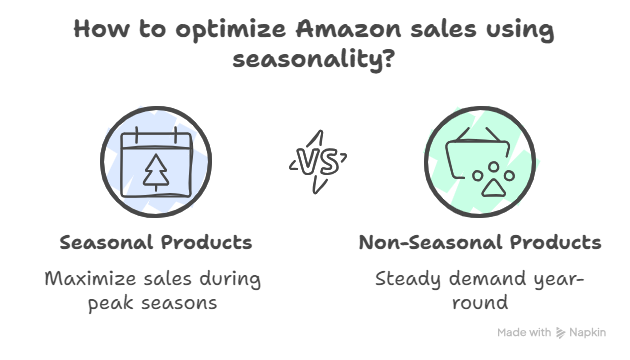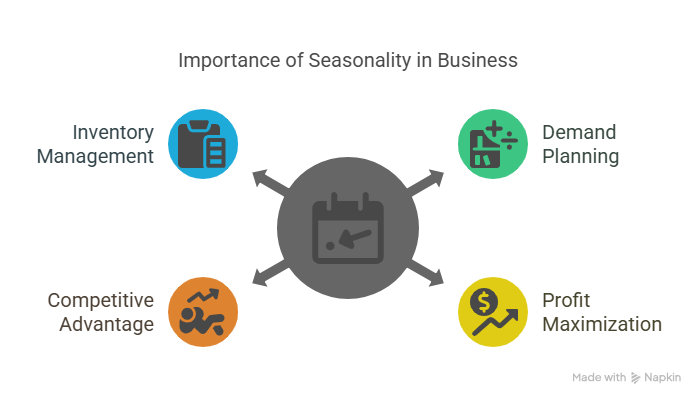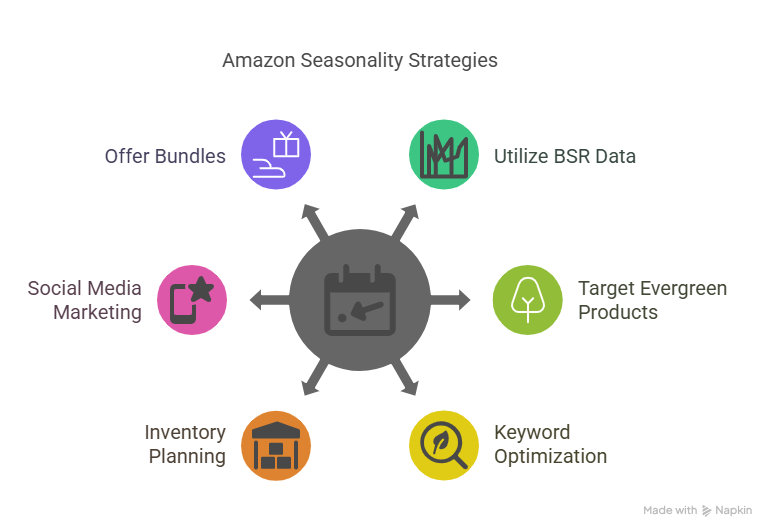Article
Why Seasonality Matters in Amazon Product Hunting & How to Leverage It

Share
Why Seasonality Matters in Amazon Product Hunting & How to Leverage It
When you are venturing into the realm of Amazon FBA (Fulfillment by Amazon), perhaps the most important and yet often underrated aspect of choosing products is seasonality. Sure, the thought of searching for trending products with low competition can be alluring, but without taking seasonality into account, your profits could take a hard hit. Seasonality is not just a fad nay, ’tis a mighty force that can destroy your Amazon business.
In this blog, we will discuss why seasonality is important in Amazon product hunting and how you can use it strategically to maximize your profits and sales.
What is Seasonality in Amazon Product Hunting?
Seasonality is the variation in product demand during the course of a year. Some products sell in high volume only at certain times of the year—such as Christmas decorations in December or sunblock in the summer. Knowing seasonality is knowing that some items are always in demand, but others are only trendy for certain periods of months or seasons.
For example:
- Christmas lights are popular only around holidays.
- BBQ grills experience higher demand in the summer season.
- Warm coats are in higher demand in fall and winter.
- Seasonality can also be seen in larger categories, such as outdoor sporting goods or back-to-school items. By monitoring these fluctuations, you can more accurately forecast when to stock up, when to increase marketing, and when to change your product focus completely.

Why Does Seasonality Matter?
Sales Volume and Demand Peaks
One of the simplest reasons why seasonality matters is that it affects demand for particular products directly. If you are selling something that’s in great demand at a specific time, understanding when this is will help you plan stock accordingly. If you don’t plan, you may either sell out too soon or be stuck with leftover stock after demand has dried up.
Profit Margins
Numerous seasonal items are able to sell for more money when demand is high, and this can dramatically increase your profit margins. To illustrate, selling Christmas decorations or Halloween costumes during the months prior to the holiday season frequently permits you to charge more and gain greater margins because of the urgency people have to buy in a timely manner. Without seasonal awareness, you may not be aware of these profit-enhancing situations.
Less Competition
By targeting seasonal products when you should, you also have the benefit of lower competition. Being ahead of the curve, you can make the most of the influx of buyers when other sellers are still busy restocking their shelves.
Forecasting and Inventory Management
Successful inventory management is crucial for running a successful Amazon business. Familiarity with seasonal trends enables you to project your inventory needs clearly, avoiding stockouts as well as overstocking, which may lead to extra expenses. Lack of knowledge of the seasonality may lead to expensive errors that influence your cash flow and storage charges.

How to Leverage Seasonality in Your Amazon Product Strategy
Now that we know why seasonality matters, let’s dive into some action steps for applying it to your Amazon product scouting:
Utilize Amazon's Best Seller Rank (BSR) Data
Amazon’s Best Seller Rank (BSR) is one of the fundamental tools for checking a product’s popularity in its category. Look at the changes in BSR over time across your potential target product categories in order to capture seasonal fluctuations. If, say, you’re selling equipment used for the outdoors, keep tabs on the difference BSR sees when spikes in sales in spring and summer hit.
How to Use It:
- Keepa or CamelCamelCamel kinds of tools observe past BSR and let you identify trends.
- Use this data to forecast the high-demand months for particular products and get your listings ready well in advance.
Target Evergreen Products with Seasonal Peaks
Although it’s easy to bet the farm on purely seasonal items (such as Christmas lights), a better strategy is to concentrate on evergreen items with steady demand but seasonal spikes. Consider items such as yoga mats, exercise equipment, or personal fans, which are sold throughout the year but have increased demand during certain seasons.
How to Use It
- Look for products that are widely popular but that also see seasonal demand spikes during specific times of the year.
- For instance, if your store sells home fitness equipment, you can market to the January “New Year’s resolution” crowd and then market to fitness fanatics year-round.
Keyword optimize your product listings for seasonal keywords
When you determine seasonal patterns, revise your Amazon listings so they contain seasonal terms that shoppers will use in peak seasons. These are such terms as “summer sale,” “holiday special,” or “back-to-school.” Make your product title, bullet points, and description update accordingly so products become visible at peak demand.
- Update your listings every quarter to ensure you’re leveraging the most relevant keywords for the upcoming season.
- You can also run seasonal pay-per-click (PPC) ad campaigns targeted at these keywords.
Plan Inventory and Replenish Early
Plan your stock ahead of time by knowing your product’s cycle of demand. If your product is going to be sold out during the run-up to a peak season, order additional stock well ahead of the peak demand time. Think about using a logistics partner to assist in streamlining your supply chain and avoid any delays.
How to Use It:
- Track inventory turnover rates on your products and make adjustments accordingly.
- Plan ahead for storing products if you are expecting a lot of inventory, and track Amazon’s storage fees.
Track Seasonal Trends and Utilize Social Media for Marketing
Seasonal trends are usually dictated by external circumstances such as holidays, weather patterns, or events. Keep abreast of these changes via social media, Google Trends, and other means in order to time your promotions. Marketing your products on social networks ahead of and during high seasons can generate more traffic and sales.
How to Use It:
- Set reminders for important season dates (e.g., Black Friday, Mother’s Day, etc.).
- Leverage seasonal trends on social platforms such as Instagram and Pinterest to post promotions and interact with your target market.
Offer Bundles or Limited Edition Products
Make bundles or limited edition products during peak season to generate sales and inspire the sense of urgency. For instance, during summer, you may bundle a camping tent with a portable stove, or provide a limited edition Christmas gift package.
- Provide bundle discounts or offer special “seasonal” editions of your products.
- Utilize Amazon’s “Limited Time Deal” option to create buzz for your products.

Conclusion
Seasonality is one of those elements of Amazon product hunting that cannot be wished away. If you’re offering a holiday-themed item or an evergreen product that experiences seasonal fluctuations, knowing and tapping into seasonality can provide you with a huge competitive advantage. By utilizing trend-tracking tools, optimizing listings, forecasting inventory, and merchandising with seasonal purpose, you can better position yourself for success on Amazon. A bit of planning and strategy, and seasonality is no longer the enemy, but a potent force to propel your Amazon business into the stratosphere.
So go ahead and capitalize on the seasons approaching and begin planning now! Your future profitability is at stake.